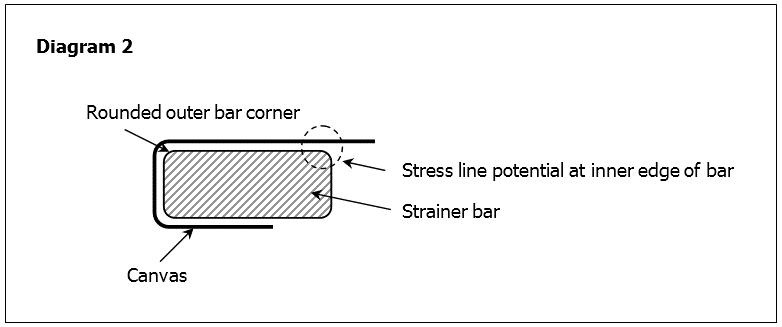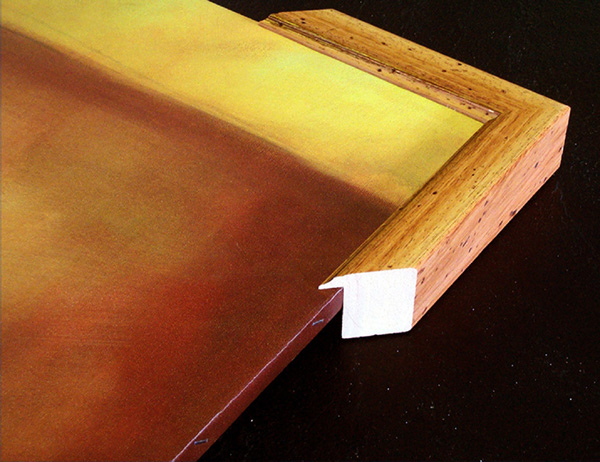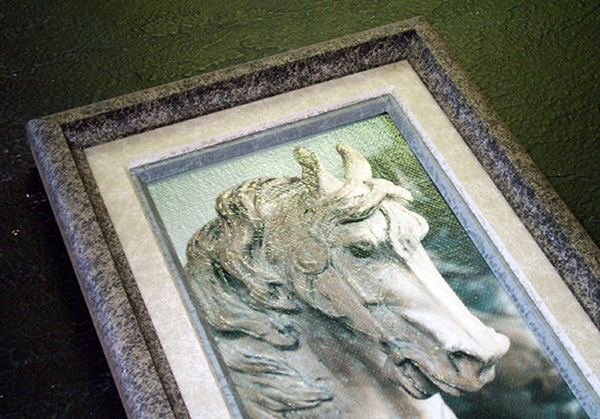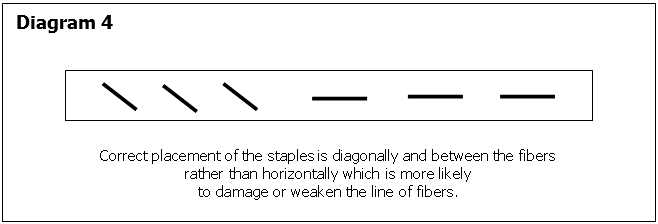 Photo 1: Standard Edge Staples
Photo 1: Standard Edge Staples
The open edition print is edge stapled onto bars for fitting into a deep moulding. This is not a preservation application. Print courtesy Wild Apple Graphics, moulding from Larson-Juhl.
As an art major in college I learned about canvases, their differences, preparation and how to stretch them…for painting. Then by the late 80's canvas took on a new look for me, I discovered an adhesive covered heat activated (HA) canvas that was being sold into the photographic market because the manufacturer stated, “...picture framers would never want it.” I wrote my first article about the transferring of photographs to this canvas product in 1991 in an attempt to prove them wrong, the rest is history.
In 2004, canvas remains all the rage. The consumers' desire for art on canvas, or the illusion of an original, has kept canvas alive as a wide variety of images including: in-house transfers, commercially produced transfer, lithographic open edition paper based canvas look a-likes, and limited edition canvas runs from publishers. In today's digital age the trend has evolved into the production of canvases printed with wide format digital printers using an assortment of ink technologies. Even though these images are all considered canvas art they are all different species of canvas, making them very different animals. So how does mounting of these various canvases vary?
In this first of a two-part article, I will examine more traditional canvases then next month concentrate on the mounting of canvases from today's contemporary reproduction market. Traditional methods of preservationally stretching original oil canvases will always be practiced. Paul McFarland is our industry canvas specialist and I will leave the details of handling and fitting originals to him. As the mounting and laminating specialist I am more interested in open edition and printed canvas reproductions in the 21st century. So, let us begin at the beginning by going back to the basics by examining supports, substrates and mounting options.
Painted Canvases
Like any wet media, oils are soft when wet and require a more solid surface to be applied to fabric historically being that substrate. Canvas has come to be the somewhat generic term for all painting fabrics regardless of their actual origin, but canvas, linen and cotton are all fibers derived from natural plants used to make the primary support for the painting of oils and acrylics. Other wet mediums may also be applied to canvas including gouache; casein; tempera; even house paint as seen with Jackson Pollack in the 50's.
Canvas is a lightweight and relatively economical substrate for any painting medium regardless of overall size, but as a soft fabric it requires additional support prior to painting, viewing, and framing. Hence the practice of stretching raw or primed canvas around the edges of a stiff wooden support became necessary. This secondary support is referred to as a stretcher frame.
Canvas Textures, Weights and Colors
There are numerous raw canvas textures available from coarse to fine weave, knobby uneven threads to even refined threads all determined by the thickness and tightness of the thread patterns in the fabric (photo 1). Unlike the visual textures of printed canvas reproductions these are tactile textures with real canvas that have a distinct variance in the surface, detectible to the eye and the touch. Selection of a weave pattern is a matter of individual taste whether by the artist for original oil or the framer when transferring. Colors of canvas range from bleached white to shades of natural beige.
 Photo 1: Standard Edge Staples
Photo 1: Standard Edge Staples
The open edition print is edge stapled onto bars for fitting into a deep moulding. This is not a preservation application. Print courtesy Wild Apple Graphics, moulding from Larson-Juhl.
Canvases are also available in various weights. Generally 10oz. or 12oz. cotton are the most popular, but stiffness of a raw canvas is determined by the sizing or gesso coating added to natural soft fibers to prepare the surface for paint. In the next issue I will discuss a different type of coating applied to raw canvases in preparation for use with inkjet and wide format digital printing. In any event, it only stands to reason the more a naturally soft fiber is bleached, sized and treated the stiffer it may become making them more difficult to stretch.
Wooden Supports
There are two basic types of wooden supports: strainers and stretcher bars (diagram 1). Strainers are wooden frames that are solidly affixed by glue and nails at the corners with no corner key mechanisms allowing for the adjustment of canvas tension. They have a full rectangular profile leaving the inner edges in contact with the stretched canvas. This does not allow for the stretched canvas to be suspended away from the inner corner creating the potential for image indentation and damage at the stress point (diagram 2).


Stretcher frames, also called stretcher bars, have small wooden keys at the corners for fine tune expansion adjustments as a canvas expands with time, humidity and environment. Bars come in a variety of basic shapes and sizes to accommodate the size and weight of the canvas to be stretched and have a lip at the outer top edge for free extension of the canvas with no contact to the wood frame beneath (diagram 3).

Printed Canvases
Open edition offset lithography has been reproducing visual oil paintings on smooth paper for a very long time. With the popularity and demand for oil reproductions to look like oils, manufacturer's answered the call and the practice of printing them to textured canvas or canvas textured paper has flourished. But when is a canvas not a canvas? And how should these images be framed? Photographic visually textured canvas on paper are not real oils and may be dry mounted and glazed accordingly. Offset lithographic canvas reproductions do not act like the real thing and must be protected since they cannot be stetched without additional treatments like canvas transferring.
Canvas Transfers
Canvas transfers are copyright free prints that have coated or surface laminated, soaked, peeled, then applied to canvas. They may be done commercially often using chemicals, or the surface laminated ones are easily done in-house by the framer. Once tranfered they may be stretched to bars or dry mounted to a solid substrate like a thick foam board and textured with acrylic brush strokes for realistic authenticity. A canvas that has been stretched onto bars must be fitted into a frame deep enough to accommodate the added wood supports (photo 2). Transferring is not a preservation application.
 Photo 2: Carousel Horse Transfer
Photo 2: Carousel Horse Transfer
This is a 7x10” photo canvas transfer that was mounted to HA canvas, textured and dry mounted to a ³⁄₁₆” foam board substrate for fitting into a shallow depth frame. It was double matted with paper wrapped foam board mats as a substitute for more typical linen liners and has no glazing because of the surface lamination. Photo courtesy of Designs Ink.
If stretched and textured they have the look and feel of an original oil painting, but do not react like the real thing. They are tougher to stetch because of the added layer of vinyl or liquid coating that has been applied to the surface, plus they react more to the highs and lows of temperature and humidity. Small images are the toughest to stretch but have fewer issues with sagging while larger transfers may never seem to feel taught.
Inkjet images that have been printed to canvas are very different from paper reproductions as they are on a treated canvas fabric. Ink coated paper or will not stretch like a textile, and will often sag or buckle after stretching. Printed canvases may tolerate heat depending upon the printing technology and some may be dry mounted to a rigid substrate such as 8 ply, foam board or reasonable mounting board with a porous permanent adhesive.
My suggestion is to sacrifice the soft surface of a stretched canvas and mount them a rigid substrate. It will look like a canvas yet be mounted as a paper print (photo 3). If surface laminated it will never require glazing as the vinyl is considered a glass substitute. By mounting to a substrate rather than stretching to bars the completed trasfer is much thinner and may be fitted into a shallower moulding than in photo 1.
 Photo 3
Photo 3
For additional information on image transferring see past PFM articles: "Photos to Canvas to Cash”, May 1991; "Canvassing Images" (Parts 1-2-3), October-December 1994; “Textures and Colors of Canvas Transferring”, May 1998; “Watercolor Transfers”, June 1998; "In-House Canvas Transfers", March 2002; and Chapter 9, “Image Transferring” in Creative Mounting Wrapping And Laminating available from PFM PubCo.
Canvas Stretching
Traditional canvases are pulled tightly around the edges of bars and stapled to the sides for presentation. Stainless steel staples should be diagonally aligned rather than horizontal and parallel to the plane of the painting. Since the act of stetching is rather invasive, a diagonal placement of the staples ensures least amount of fiber damage during stretching (diagram 4).

When stretching canvas transfers and wide format digitals the issue of sagging is foremost. Even using a canvas puller it is often difficult to achieve taught fabric. And it is nearly impossible to prevent sagging because of the nature of the vinyl materials when surface laminated. Vinyl expands and stretches when warm and retracts when cool making it nearly impossible to ensure a constant well stretched image.
The additional thickness of a transfer also makes it very tough to successfully stretch and the corners become quite bulky. As a result, placing the stretched images in a free float canvas frame that allows for visible corners would not be the best choice for moulding. A regular canvas depth frame is best. More on this in April.
More to the Story
After reviewing oils, prints and transfers…I am afraid this is still only the beginning of canvases. Next month I'll conclude this discussion with gicleés, open edition digitals and deep wrapped unframed canvases. Stay tuned and Happy Valentines Day, maybe your sweetheart needs a newly stretched canvas for the bedroom.
END
Copyright © 2004 Chris A Paschke
For more articles on mounting basics look under the mounting section in Articles by Subject.
Additional information on all types of mounting is found in:
The Mounting and Laminating Handbook, Second Edition, 2002,
The Mounting And Laminating Handbook, Third Edition, 2008 and
Creative Mounting, Wrapping, And Laminating, 2000 will teach you everything you need to know about getting the most from your dry mount equipment and materials as an innovative frame designer.
All books are available from Designs Ink Publishing through this website.
Chris A Paschke, CPF GCF
Designs Ink
Designs Ink Publishing
785 Tucker Road, Suite G-183
Tehachapi, CA 93561
P 661-821-2188
chris@designsinkart.com